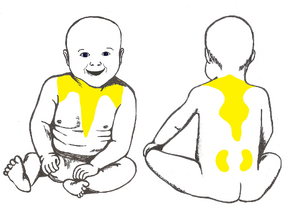Non-shivering thermogenesis
Chemical (non-tremor) thermogenesis takes place in brown adipose tissue. For humans, it is of fundamental importance in newborns, when it allows heat production to be increased up to twofold. Brown fat is found in the area under the shoulder blade and around the large vessels, even in an adult. However, the importance of this mechanism is considerably lower in adults and allows an increase in heat production by 10-15%.[1]
Noradrenaline from sympathetic nerve endings or an increased level of adrenaline in the peripheral blood activates the protein thermogenin (uncoupling protein 1, UCP1) via β 3 -adrenergic receptors.[2] This will allow the respiratory chain to be uncoupled from ATP production on the inner mitochondrial membrane . The proton gradient is thus used to produce heat.
Links[edit | edit source]
Reference[edit | edit source]
- ↑ GUYTON, Arthur C – HALL, John E. Textbook of Medical Physiology. 11. edition. Elsevier, 2006. pp. 782–784. ISBN 978-0-7216-0240-0.
- ↑ >-,. Wikipedia: The free encyclopedia: Thermogenin [online]. [cit. 2011-04-16]. <https://en.wikipedia.org/wiki/Thermogenin>.

